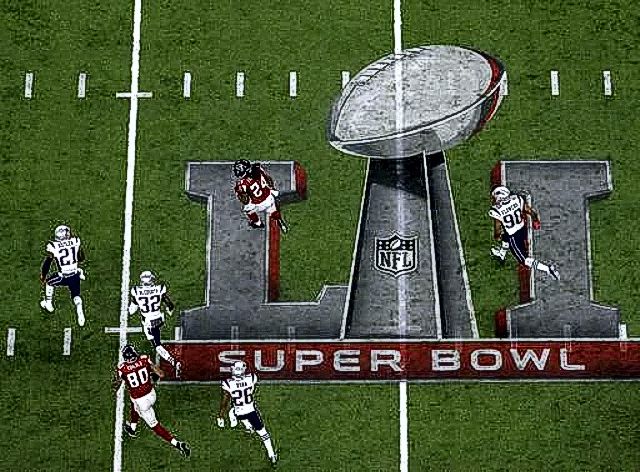The Super Bowl (henceforth SB) is an American institution, a game watched by an estimated 110M people in the US and another 38M around the world. Of course, this pales in comparison to the FIFA World Cup final watched by 900M around the world, but the World Cup is held every four years.[1] SB is televised to an estimated 180 countries, streamed live on the Internet, and translated into 25 languages. The SB has grown in every measure since its inception in 1966, and today is truly an American extravaganza with everything done in typically American fashion — over the top. Like Disney World, the Mall of America, the world’s tallest roller coaster, and supersized fries, we live in a land of excess, so why should our games be any different?
To support my contention, a few tidbits about the SB illustrate my point:
- Attendees spent a bundle for tickets, meals, transportation, lodging, team swag, etc. The cheap seats
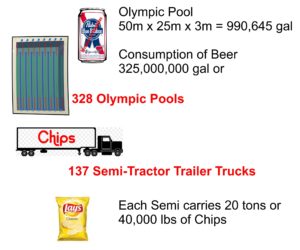
Figure 1: Beer and chip consumption during the Super Bowl. See text for sources.
(upper level end zone) went for $2700 ($45/minute of viewing pleasure), “Best Value Seats” for $3000 each ($50/min), for the Best Seat Under $5K” you can squeak in at $4,750 ($79/min), while the high-priced version for the unwashed masses went for $9,000 each ($150/min). If you are a cooperate mogul and/or a rich, rabid football fan, you can you purchase a luxury suite that includes an allocation of tickets for prices that vary by size and location. Individual box seats in a common suite (only one step removed from the proletariat) start at $10K, while fully private suites start at $150,000 including 26 tickets. [2]
- During the event Americans consumed 158M avocados, 11M pounds (5,500 tons) of chips, and 325M gallons of beer. To put that in perspective, that amounts to about a gallon of beer for each person in the US. Now accounting for those that didn’t watch the SB and those that don’t drink beer, it seems likely that many people consumed more than their share on game day. The average viewer consumed 2,400 calories of snacks on Super Bowl Sunday, making it #2 on the holiday gluttony list, second only to Thanksgiving. [3] On average, viewers of the Super Bowl spent $78 on food, beverages, and team merchandise.[4] Ironically, two of the major sponsors were Pepsi Sugar-Free soda and Bud Light amid all the chips and dip, pizzas, fried chicken, and hot wings. It seems that people are still concerned about dieting.
- The average salary for an NFL player for the 16-game season (exclusive of bonuses, etc.) is just shy of $120K per game. Put differently, most professional football players get paid for sitting on the bench. Quarterbacks, however, are not average, however, Matt Ryan of the Falcons (11th highest paid in the NFL in 2016) receives $20.75M (1.7M/game) while Tom Brady of the Patriots, squeaks in at #12 getting a paltry $20.5M ($1.3M/game).[5] Given that more than 45M people (14.5% of the population) lived below the poverty level – that is $11,490 for a single person and $23,550 for a family of four, NFL salaries are obscene.[6]
-

God and Football
Lest you think religion is left out of the SB, except for the perfunctory invocation 26% of viewers said that God played a role in determining the outcome of the game. Hummm… what does that say about the Falcons.[7]
- And the pièce de résistance are the gaudy Super Bowl Rings. Super Bowl winning rings in 2015 cost $36,500 each and contain 4.85 carats of diamonds. The tab for the 150 purchased by the winning team was over $5M.[8] As if that was not enough, members of the winning team get a hefty $92K bonus while the first losers raked in $46,000 for the Miss Congeniality Award. [9]
-
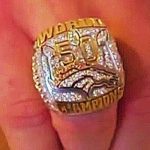
Figure 2: Possibly the gaudiest ring ever made.
Harris Interactive, a marketing research firm, estimates that 1.5M people called in sick Monday morning after the game and another 4.4M were late to work. The Super Bowl cost employers between $820-$850M in lost productivity on Monday alone as the game is played and replayed around water coolers and overly-enthusiastic fans nursed hangovers across the US [10].
So, why do millions of people watch the Super Bowl? As a quintessential American sporting event, this year’s spectacle was highlighted by an action-packed infomercial from our President, Lady Gaga and her Broadway glitz and glamour, endless analysis by talking heads, as well as what some have described as the best game in Super Bowl history.
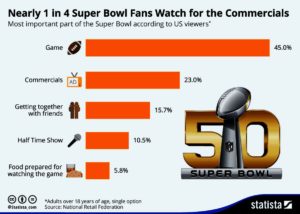
Figure 3: Reasons for watching the Super Bowl
According to the National Retail Foundation for the 2015 Super Bowl less than half of those surveyed were most concerned about the game itself. Nearly one in four were more interested in the commercials. Considering that 110M people reportedly watched the game, this means that over 25M people watched an event, not for the event itself, but for the paid commercials by American businesses. See Figure 3.
In a separate study, the Huffington Post survey obtained similar results on a separate sample, but with additional details. Table 1 shows that almost half of male viewers were interested primarily in the game, while only 20% of females were so motivated. Interestingly, almost equal proportions of the <30 and 30-44 age groups were concerned with the game and commercials, while older respondents favored the game and not the commercials. That such many viewers were primarily interested in the commercials presents an unprecedented opportunity for American business. And hence their willingness to pay handsomely for the opportunity to parade their ware in front of the buying public.
Table 1: Why Do People Watch the Super Bowl?
| Total | Male | Female | <30 | 30-44 | 54-64 | 65+ | |
| The game itself | 35 | 49 | 21 | 24 | 35 | 35 | 46 |
| Commercials | 26 | 21 | 31 | 26 | 33 | 28 | 13 |
| Halftime show | 9 | 4 | 13 | 10 | 11 | 9 | 2 |
| No sure | 5 | 6 | 4 | 13 | 5 | 2 | 2 |
| Don’t watch | 25 | 19 | 31 | 26 | 17 | 25 | 37 |
Ads for the SB are big business. For the SB this year advertisers paid nearly $5M for a 30-second ad. Since its inception, the marketing potential has been recognized and exploited by the major television networks. The rates for a 30-second commercial from 1967-2015 are shown in Figure 5.
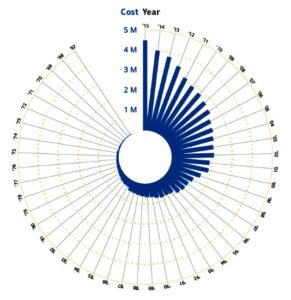
Figure 4: Cost of a 30 second commercial during the Super Bowls (1965-2016
Of the roughly 3.5 hours of air time devoted to the SB, viewers saw between 40-50 minutes of 80-110 commercials. See Figure 6 for actual data for Super Bowls from 2002-2016.[11]
One quarter of those who watched did so because of the commercials. Think about it. What would someone have to pay you to sit for 3-4 hours to watch intermittent television commercials? For those interested in the game, the data are staggering, but in an unexpected way. Excluding commercials and FOX self-promotion advertising, the time the ball was in play for a scant 8.61% of total air time, while nearly 30% of air time was devoted to paid commercial and FOX self-promotion. Other activities are shown in Figure 5. In all fairness, the largest proportion of time was devoted showing the field without the ball in play. Viewers spent over an hour watching grown men stand around in small groups scratching, spitting and patting each other on the butt. If you add replays to that total virtually half the game was game filler, one third was commercials, and the remainder was taken up with the halftime show, the halftime report, miscellaneous
activities, and the game itself.
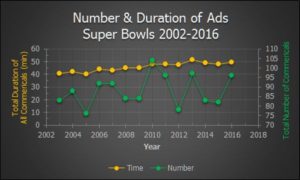
Figure 5: Ads 2003-2016
While the SB is touted as the football world championship, it is nothing more than an outrageously expensive venue for advertising. I dare say when asked most people would be reluctant to spend three and a half hours simply to watch ads. Even sadder, are the “fans” who drank of Kool-Aid and bought a ticket. Only in America, land of the free and
home of the gullible.
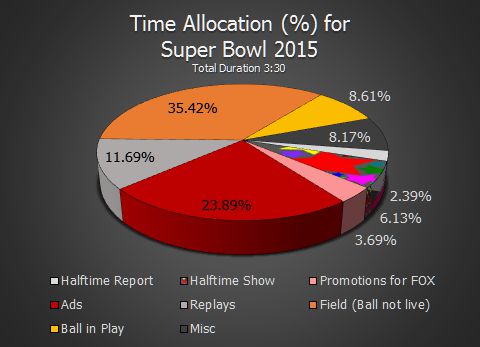
Figure 6: Time allocation during the SB.
References
[1] http://www.ibtimes.com/how-many-countries-will-watch-super-bowl-1799734
[2] http://www.cbssports.com/nfl/news/want-2017-super-bowl-tickets-from-the-cheap-seats-to-the-absurdly-expensive/
[3] http://time.com/money/3686318/super-bowl-facts-stats/
[4] http://time.com/money/3686318/super-bowl-facts-stats/
[5] http://www.ibtimes.com/super-bowl-2017-money-how-much-do-players-get-paid-winning-how-much-do-losers-get-2485690
[6] http://www.huffingtonpost.com/2014/09/16/poverty-household-income_n_5828974.html
[7] http://time.com/money/3686318/super-bowl-facts-stats/
[8] https://www.bustle.com/articles/140329-how-much-do-super-bowl-rings-cost-the-value-has-gone-up-since-the-first-championship
[9] http://time.com/money/3686318/super-bowl-facts-stats/
[10] http://www.bizjournals.com/orlando/morning_call/2013/02/how-much-productivity-is-really-lost.html
[11] https://www.statista.com/statistics/251588/number-and-length-of-network-tv-commercials-in-the-super-bowl/
EO Smith
Latest posts by EO Smith (see all)
- Patriotism - 4 July, 2017
- The Super Sucker Bowl - 10 February, 2017
- Alternative Facts and Science - 24 January, 2017


